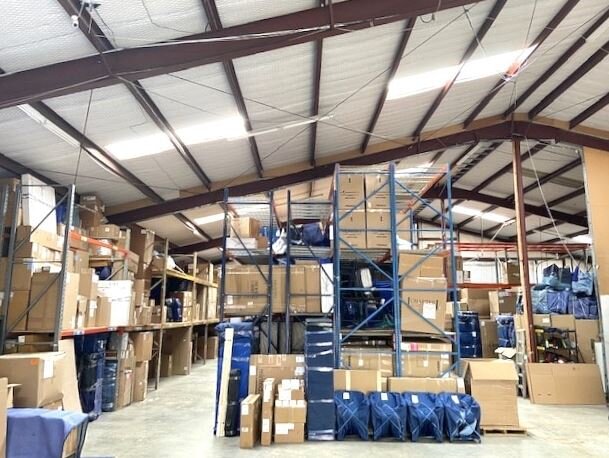Establishing a strong relationship with a receiving company is crucial for operating an interior design business. However, receiving companies vary in quality, so it’s important to research and collaborate with one that has an excellent reputation before sending your products to their warehouse.
What is a Receiving Company?
A receiving company is a warehouse that accepts parcel and freight deliveries. They inspect and document items, assemble them if necessary, protect and package the items, and store them until it’s time for delivery. They provide white-glove delivery and installation, and also remove all packaging from the premises.
If an item arrives damaged, the company will communicate with you to determine the best course of action. A good receiving company will have a furniture repair team that can fix minor damages without needing to replace the item.
Why is a Receiver so Critical?
Utilizing a receiver for your projects will vastly streamline your implementation process. Consider the alternative for a moment.
Scenario #1 – Shipping items to your home/office.
Receiving products at your office, particularly if it’s a home office, can be quite inconvenient. You must promptly open and inspect the items for any damage and then manage the packaging material. Moreover, you require sufficient space to store the items securely until installation. After receiving everything, it’s essential to plan how you will transport the items. Will they fit in your vehicle, or will you need to rent a truck?
Scenario #2 – Shipping items to your project site
When managing a project where your clients reside on-site or work from home, it might be tempting to have items shipped directly to them and ask for inspection upon arrival. However, this could potentially become burdensome for your client, leading to them underestimating the time and responsibility involved. Additionally, you would need to consider how to manage the packaging waste that comes with each shipment. Furthermore, the package might arrive with a receipt displaying your trade pricing, which could be undesirable.
Navigating Logistics and Planning for Project Shipments
When receiving shipments for your project, it’s important to keep in mind that while smaller items may be delivered in a regular box, larger items like furniture will likely be crated. Unpacking these crates requires physical strength and proper tools. Additionally, many vendors don’t ship directly to residential addresses and instead require a receiving location with a loading dock, so it’s crucial to plan for this logistics.
If you’re considering “white-glove” delivery, it’s essential to have someone available to receive the item during the specified delivery window. An alternative would be to coordinate with your client to ensure that the delivery aligns with their schedule.
It’s also crucial to consider the impact on your project. For instance, if your project is undergoing major construction, storing and receiving products might not be feasible. This consideration can help you make informed decisions and avoid potential disruptions.
While it’s true that using a receiver comes at a cost, the convenience and time saved often outweigh the expense. Remember that if you handle receiving on behalf of your client, they will probably be billed for your time. By considering the value gained from using a receiver, the cost becomes more justifiable.
How to Find the Right Receiver
Begin your research by exploring receivers in your vicinity. It is advisable to select a location near your office for ease of access, should the need for a visit arise.
- Google Reviews: Seek out warehouses that boast excellent Google reviews, underscored by numerous positive testimonials from satisfied clients.
- Peer Recommendations: Consult your industry colleagues to find out which receiving warehouses they recommend.
- Warehouse Visit: Arrange a visit to the warehouse. Request a tour and a meeting with the staff to assess the cleanliness, organization, and the professionalism of the team. Ensure the environment is conducive to accommodating your needs.
- Operational Procedures: Inquire about the warehouse’s handling processes. Most establishments implement a structured system for cataloging received items, including inspection, photographing, repackaging, and storing goods. Verify their method for accurately documenting and tracking the location of items to prevent misplacement.
- Damage Handling: Understand their policy on handling damages. Determine whether they file claims on your behalf or if you will need to manage this. Discuss how they communicate updates when items arrive, ensuring transparency.
- Bill of Lading (BOL): Confirm that the warehouse manages and maintains the Bill of Lading accurately—it’s a crucial document that records the details necessary for processing and invoicing freight shipments. This document also serves as a record of the item’s condition upon receipt, which is essential for any subsequent damage claims.
- Pricing Structure: Ensure the receiver provides a clear breakdown of their service fees. Pricing models may vary, typically involving charges based on the time spent handling the product (inspection, storage, delivery, and installation) and the space occupied by the goods (charged per cubic foot). It’s important to communicate these costs to your clients upfront to avoid surprises.
Monitoring Your Goods
Contributing to a Strong Partnership
Cultivating a positive relationship with your receiving warehouse involves playing an active role as a good partner. Here are some effective ways to enhance this partnership:
- Sidemarks: When placing orders, it’s common to request a sidemark, which identifies the specific project associated with the order. For instance, we might use “KBID – Smith” to signal our involvement and clarify client ownership. This simple step helps ensure your receiver can easily identify and manage your items.
- Practice Courtesy: Maintaining a professional and polite demeanor with your receiver is crucial. Mistakes and mislabeling can occur, so it’s important to be understanding and allow your receiver the opportunity to correct issues. However, if problems persist, consider seeking a more reliable service provider.
- Tip Your Installers: Prepare to tip the individuals who deliver and install your products. Ascertain whether tips can be charged to a credit card or if you should bring cash. Often, these tips can be reimbursed by your client.
A competent and efficient receiving company not only saves you time and money but also prevents potential frustrations. Investing time in finding a supportive warehousing partner can significantly benefit your business and allow you to focus on design and management.
This post is intended to motivate you to either solidify a partnership with a reliable warehousing provider or reconsider your current one if it’s falling short of expectations.

